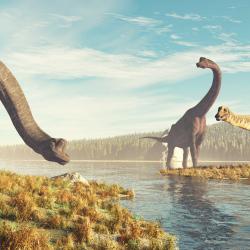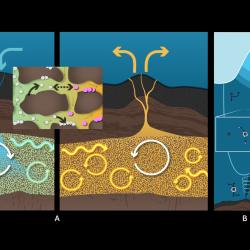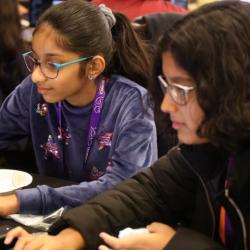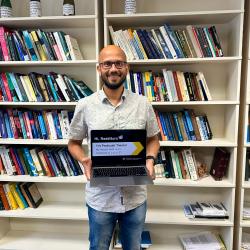Moon Orbiting ‘Dinky’ Asteroid is Actually Two Tiny Moons Stuck Together
Collectively called ‘Selam,’ the two moonlets bring new insight into the complex processes behind planetary formation and evolution.

When NASA’s Lucy spacecraft flew past its first official target Dinkinesh in November 2023, researchers discovered that the asteroid—known as “Dinky”—was not alone in space. A satellite asteroid, which the team named “Selam,” was orbiting Dinky. As Lucy sent more data back to Earth, the researchers discovered something surprising: Selam was not just one moon, it was a contact binary—or two moons melded together.
The Lucy team, which includes University of Maryland Professor of Astronomy and Geology Jessica Sunshine, detailed the unexpected finding in a paper published in the journal Nature on May 29, 2024. The researchers noted that the unusual arrangement challenges existing theories about how asteroids and other celestial bodies formed over time and provides additional insight into the internal structure, dynamics and evolutionary history of both Dinky and Selam.
“There’s a lot more complexity in these small bodies than we originally thought,” said Sunshine, a co-author of the paper. “With the additional observations taken by the spacecraft, we were able to better analyze features such as Dinkinesh’s rotation speed and Selam’s orbit pattern. We also have a better understanding of what materials they’re possibly made of, bringing us a step closer to learning just how terrestrial bodies are created.”
Images taken by the Lucy spacecraft revealed a trough on Dinkinesh where about a quarter of the asteroid broke off from its main body, a ridge that formed after the asteroid’s structural failure and the contact binary now known as Selam (which was named after the child counterpart of the Lucy hominin fossil discovered in 1974). The team theorized that Dinky’s fast spinning motion—boosted by the uneven reflection of sunlight off the asteroid’s surface—caused it to shed and eject rocky debris into orbit. Some of the debris could have aggregated to form Selam, while another portion of the fragments rained back down on Dinky as boulders and created the ridges photographed by the Lucy spacecraft.
“One of the things that’s critical to understanding how planets like Earth got here is understanding how objects behave when they hit each other, and to understand that we need to understand their strength,” said lead scientist Hal Levison of Southwest Research Institute, Boulder, Colorado, principal investigator for the Lucy mission. “Basically, the planets formed when [smaller objects like asteroids] orbiting the Sun ran into each other. Whether objects break apart when they hit or stick together has a lot to do with their strength and internal structure.”
The team deduced that Dinky likely had some internal strength, which allowed it to maintain most of its form.
Just how Dinky’s unusual dual moons formed remains a mystery, but Sunshine said that the team’s findings open the door to comparative studies with similar celestial bodies.
“I’m personally very excited to compare the Didymos binary system with this one, especially as they appear to share many similarities such as size, general shape and possibly composition despite being in totally different parts of the solar system,” explained Sunshine, who was also on NASA’s DART research team and helped detail the DART spacecraft’s successful deflection of Didymos’ small moon called Dimorphos.
“The Didymos binary system is located in a near-Earth environment while the Dinkinesh system is located much farther away from Earth in the main asteroid belt,” she added. “They have very different features but we think they may have undergone similar processes to become what we know of them today.”
Dinkinesh and its satellite are the first two of 11 asteroids that Lucy plans to explore over its 12-year journey. After skimming the inner edge of the main asteroid belt, Lucy heads back toward Earth for a gravity assist in December 2024. That close flyby will propel the spacecraft back through the main asteroid belt, where it will observe asteroid Donaldjohanson in April 2025, and then move on to observe the Trojan asteroids in 2027.
“Our ultimate goal is to understand the formation of celestial bodies,” Sunshine said. “How do planets form? How was Earth formed? We know that big planets are formed by smaller bodies, so studying these little asteroids lets us see how materials behave and interact on a smaller scale. With Dinky and the other asteroids we’re flying by, we’re laying the groundwork for understanding how planets are made.”
###
The paper, “The Discovery of a Contact-Binary Satellite of the Asteroid (152830) Dinkinesh by the Lucy Mission,” was published in Nature on May 29, 2024.
The Lucy mission is funded through the NASA Discovery program (Contract No. NNM16AA08C). This story does not necessarily reflect the views of this organization.
This article was adapted from text provided by the NASA Goddard Space Flight Center.







